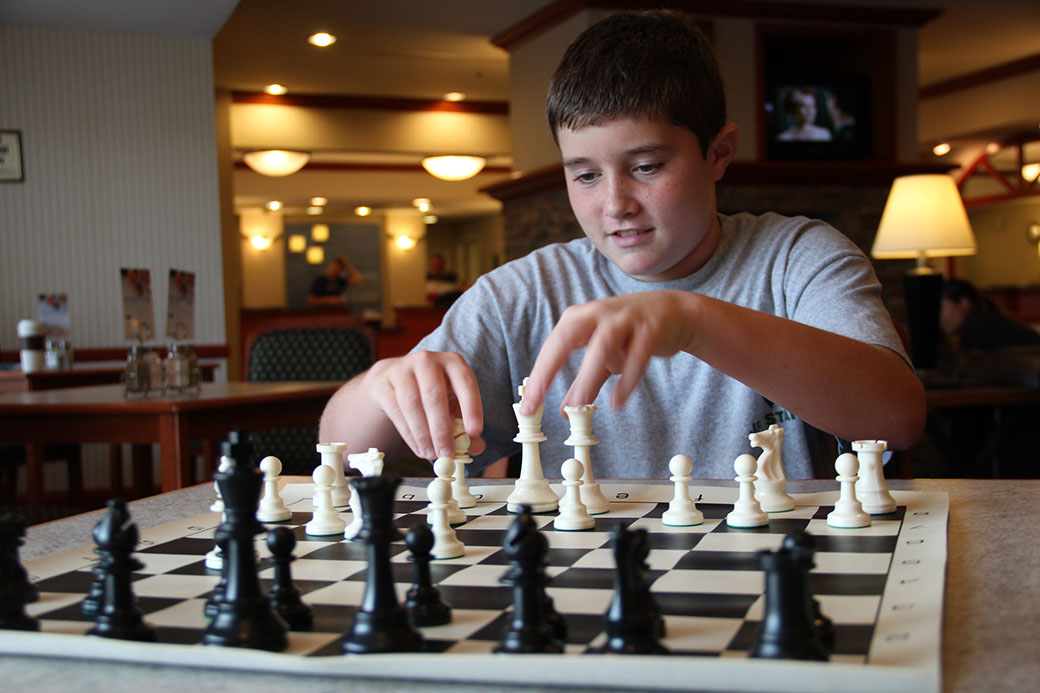
State chess organizers attempt to restart USD club
Jackson Geerts looks almost cherubic behind a chess board with his brown doe eyes and baby-fat cheeks. But when the 11-year-old smirks, his competitors know the Sioux Falls fifth-grader is one step closer to the kill — or rather checkmate.
“Defense, then offense. I want to attack usually, but in tournaments, I can’t get away with it,” Geerts said.
He is one of the seven members in Robert Frost Elementary’s chess club, but over the weekend, the young boy left his primary school roots behind to compete against some of the state’s top players at the South Dakota Chess Championship in Vermillion.
Sixteen participants arrived for the two-day event, which was hosted by the South Dakota Chess Association at the Holiday Inn Express. Geerts, who is ranked 50th in the state, lost all four of his matches and took a bye for the last round, but held his own for 61 moves against an older opponent ranked 15th.
The fifth-grader participates in football, basketball and baseball. He even plays the bass for his school’s orchestra. But it is the strategy and tactical thinking required to play chess that Brian Geerts, his father, said his son applies to everyday activities.
“When he plays football, he sees the quarterback as the king and the linemen as the pawns,” Brian Geerts said.
More chess clubs and summer programs are being offered to young players in the state, said Mark Derby, an officer for the SDCA and organizer of the Vermillion tournament. The state association is attempting to rekindle interest in the sport on college campuses though, which is why Vermillion played host to this year’s state tournament, Derby said.
The University of South Dakota’s chess club is no longer listed on the student portal, and its membership has dwindled to about five members. Mark Hansen, a former USD student, still shows up to occasional games on Sundays at 6 p.m. in the Muenster University Center, but said he was disappointed no USD students competed in the weekend tournament.
This was not the case when Derby started working at the university in the 1990s. Chess club attendance fluctuated, he said, but tournaments such as the now-defunct Coyote Classic drew top players to USD.
“When USD’s chess club was active, we had international masters — some of the best players out there — coming to campus,” Derby said. “I’m hopeful there are students who play online and just don’t realize there are other students they can play against.”
A 1997 article from The Volante captured a Friday night event held by the club that included former state champion and non-traditional USD student Steve Norquist simultaneously taking on eight people in chess. Norquist was rated 2,036 and ended the night by winning six games, losing one and drawing another.
Any chess player with a rating over 2,000 is considered an expert, or “grandmaster.” This rating is based on a mathematical formula, which measures the wins and draws against opponents at tournaments. The highest ranked player: American chess prodigy Bobby Fischer at 2,785.
The history of chess spans over 1,500 years, but Jill Likens, 54, cares most about what the game did for her more than three decades ago. Likens went to her first chess tournament as a student at the South Dakota School of Mines and Technology with her then-boyfriend. It was this tournament where she met her husband, Terry Likens, 62, who she said was “chatting her up in the hallway” while he played in the tournament.
Likens and her husband have been married for 35 years and primarily live in Watertown, S.D. Both competed in the state tournament in Vermillion, but Likens said it is her husband, who happens to be one of the main tournament directors in the state, who is a real student of the game.
“I’m an engineer, so I use chess as a way to relax and de-stress,” she said. “But Terry — he has like 500 books about chess in our house.”
Lyle Hanson, 55, knows exactly the kind of chess Terry Likens likes to play. Hanson traveled from Rapid City to compete in the tournament and won a four-hour match against Likens in the fourth round. Hanson would go on to become this year’s tournament champion.
Hanson began to play chess as a 10-year-old in Minot, N.D., and started to compete in tournaments at about 14. He still gets shaky at the prospect of a good move and carries around a tissue in his pocket to wipe away beads of sweat from his brow when the competition gets fierce.
Chess has also led to unlikely friendships for the electronics technician, who is now a four-time state champion. SDSMT student Heath Milton, 26, met Hanson at a bar where the two realized their mutual affinity for the game. They meet about once a week to play chess and drove up together to compete in the state tournament.
“The way I play depends if I’m white or black on the board. But Lyle’s taught me to be patient and to look for that good sacrifice piece to win,” Milton said.
The state’s competitive chess community is a close one, but there is not one particular personality type at a tournament, Hanson said. Veterans tend to scope out the competition like they would reconnoiter an enemy’s position before battle. College professors theorize the implications of their next 15 moves, while high schoolers might impetuously rush their opening. But Hanson said no player is the same.
“There’s guys in three-piece suits. There’s guys wearing tie-dyes that look like they haven’t changed in three months,” he said.
(Photo: Jackson Geerts, 11, demonstrates a “five move checkmate” after the fourth round of the state tournament in Vermillion Sept. 28. Megan Card / The Volante)

